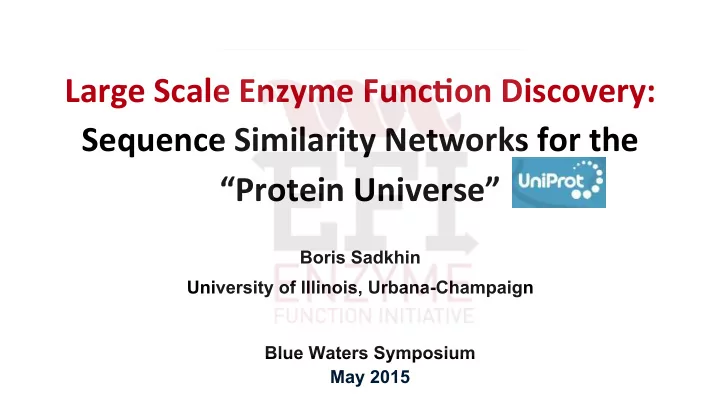

Large ¡Scale ¡Enzyme ¡Func1on ¡Discovery: ¡ Sequence ¡Similarity ¡Networks ¡for ¡the ¡ “Protein ¡Universe” ¡ Boris Sadkhin University of Illinois, Urbana-Champaign Blue Waters Symposium May 2015
Overview • The Protein Sequence Database Problem • Sequence Similarity Networks (SSNs) • EFI-EST (Enzyme Similarity Tool) • EST-Precompute
Personnel involved in this project Carl R. Woese Institute for Genomic Biology (IGB) at University of Illinois, Urbana-Champaign John A. Gerlt, PI Victor Jongeneel, CoPI Daniel Davidson David Slater External Collaborators Alex Bateman, EMBL-EBI Matthew Jacobson, UCSF
The Enzyme Function Initiative (EFI) ● The Enzyme Function Initiative, an NIH/NIGMS - supported Large - Scale Collaborative Project (EFI; U54GM093342; http://enzymefunction.org/) What do we do? ● collaborate ● create ● disseminate
An explosion of protein sequences! As of March 2015, 92,124,243 proteins had been identified.
The Problem ● The number of protein sequences is exploding! ● 50% of our protein databases are misannotated! ● There are many proteins and enzymes to discover!
The Solution A Sequence Similarity Network Database
Bridging the Gap : Biologists and Big Data
Generating the database on BW Biocluster @ IGB Blue Waters @ NCSA # of Nodes 20 EFI Nodes @24 cpu > 22,000 Nodes @ 32 cpu 20 Shared Nodes @24 cpu Storage (100TB) 600 TB for entire cluster 500 TB for just our project >90 million sequences 8 months < 2 weeks =4,243,438,028,099,403 comparisons Node hours? ● 200,000 node hours ● 6,400,000 cpu hours
What is a Sequence Similarity Network? node ¡(circle) ¡= ¡protein ¡sequence ¡ edge ¡(line) ¡= ¡alignment ¡score ¡ - log 10 [2 -bitscore • (query length • subject length)] Alignment Score
Using Sequence Similarity Networks
Using Sequence Similarity Networks
SSNS- Computationally Faster, Qualitatively Similar
Analyzing Groups of Proteins Phylogenetic Trees and Multiple Sequence Alignment Sequence Similarity Networks Dendrograms
Pros and Cons Multiple Phylogenetic Sequence Sequence Trees Similarity Alignment (MSA) Networks (SSNs) Visualization of Small Datasets Good Good Good Visualization of Large Datasets Bad Not so good Good Informative Small Datasets Small Datasets Small Datasets Large Datasets X Large Datasets X Large Datasets Computational Expensive Requires Sensitive Pairwise Sequence Alignment Cost MSA BLAST heuristics Displays No Sometimes 26 (eg...crosslinks) Annotations?
Our SSN Tools
efi.igb.illinois.edu/efi-est/
- Enzyme Similarity Tool Caveats: ● 100,000 sequence threshold for predefined families ● Takes time, networks need to be generated and regenerated for filtering
● Gene3D ● PFAM Clans ● Interpro Families ● More? efi.igb.illinois.edu/est-precompute
Full SSNs ● each node = 1 sequence Representative SSNs ● each node > 1 sequence
EST & EST-Precompute use ● widely used database of conserved protein families that are based on a seed alignment of representative sequences that are used to generate a profile hidden Markov model (HMM) ● 14,831 defined families in Pfam http://pfam.xfam.org/
Challenges: ● The “doubling time” of the UniProt database (http://www.uniprot.org/), is ~ 18 months ● Adapting the workflow and algorithms for increasingly large sequence datasets ● Dealing with major changes in the databases from which we get our data
Our Workflow
Accomplishments ● Dealing with the ‘explosion’ of protein sequences ● Algorithms ● Generated > 14,000 Pfams ● Production Pipeline
Blue Waters Team Contributions The Blue Waters Team has been helpful in dealing with our issues ● Live chat support ● Supplying job stats, optimizing our workflow, fixing software installations, you name it ● scheduler.x - the single threaded job scheduler
Thank You! Questions?
References Sequence Similarity Networks in the SFLD EFI EST http://www.sciencedirect.com/science/article/pii/ S1570963915001120 R.D. Finn, A. Bateman, J. Clements, P. Coggill, R.Y. Eberhardt, S.R. Eddy, A. Pfam Heger, K. Hetherington, L. Holm, J. Mistry, E.L. Sonnhammer, J. Tate, and M. Punta, Pfam: the protein families database. Nucleic Acids Res 2014, 42, D222-30. PMCID: PMC3965110 Uniprot C. UniProt UniProt: a hub for protein information Nucleic Acids Res, 43 (2015), pp. D204–D212 Collaborator Patsy Babbitt http://www.ncbi.nlm.nih.gov/pmc/articles/ PMC2781113/ [4] PMC http://www.ncbi.nlm.nih.gov/pmc/articles/ PMC1892569/ [5]
Recommend
More recommend